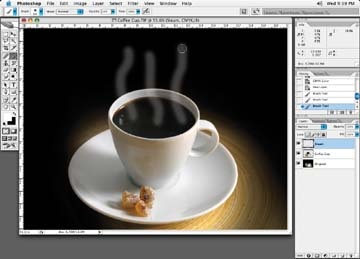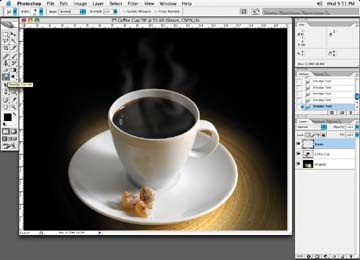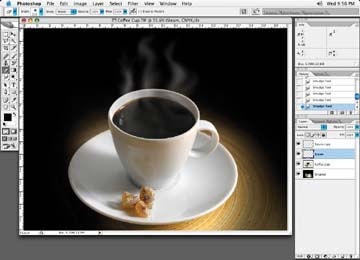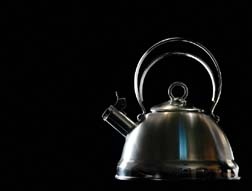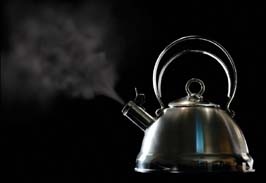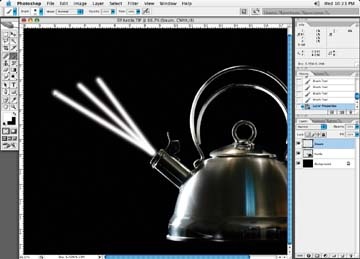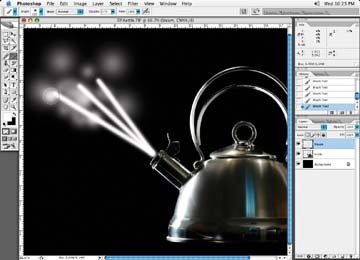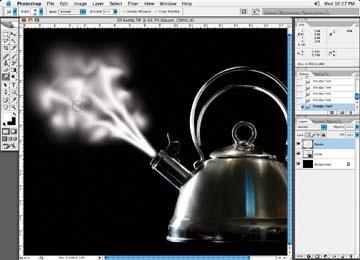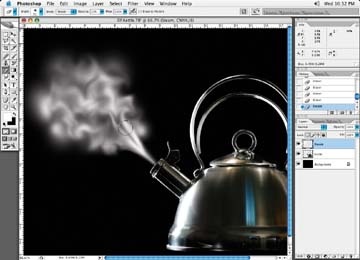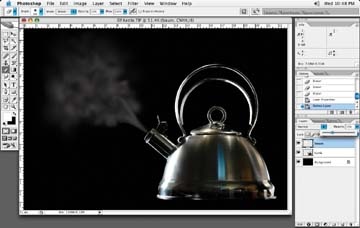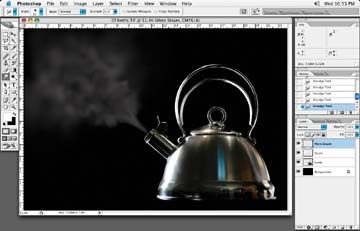In this chapter
One of the most difficult challenges of retouching is creating something that doesn't already exist. There may be a portion of an image that is missing and needs to be redrawn or made up. For example, sometimes a person's leg or finger is outside of the original shot and needs to be added in. It might be necessary to add or change a reflection to make an object look more appealing. The techniques described in this chapter will help you create something from nothing!
One common request I receive from clients is to add smoke or steam to an image. Sometimes the desired effect is wispy, floating steam to make a muffin look fresh from the oven; sometimes it's a strong, forceful stream to indicate an iron's wrinkle-fighting power. Knowing how to make steam is a handy tool.
Adding steam to a food item can immediately make it more appetizing. In this example, we'll add steam to a cold cup of coffee. By the end of this exercise, the coffee should appear hot!
Let's start with the cold, unappetizing cup of coffee in Figure 4-1. Once we add some steam, we'll be serving the much tastier looking cup shown in Figure 4-2!
First, you'll want to create a new layer. Next, select the Brush tool. Set the brush opacity to a low amount, such as 30 or 40, and set the foreground color to white. Now, brush S-shaped white vertical lines where the top surface of the coffee is, as I've done in Figure 4-3.
Once you have a few lines drawn in, select your Smudge tool and set the opacity to 50%. Shape and distort the lines with the Smudge tool, massaging the lines and pushing them around like putty until you get the look of wafting steam, as in Figure 4-4.
Feel free to create more layers and additional lines of steam, reshaping them differently each time. You do not want any two lines to look the same. You may want to set the opacity levels of the various steam layers at different levels so that the steam will appear more natural and have more of a 3D effect. You can also distort or change the height and width of the various steam layers. Figure 4-5 shows the final effect.
Sometimes you, or your client, may want to make steam appear as though it is blasting out of something, like a steam kettle, for instance. To achieve this effect, we'll add some motion to a steam layer.
Note
Other situations in which you should add motion to steam include car exhaust, airplane vapor trails, and when making someone or something appear as though it's moving quickly, creating a motion trail behind.
Figure 4-6 shows a picture of a kettle. We'll add steam in such a way that it appears to be shooting out of the kettle, as in Figure 4-7.
Once again, the first thing I would do is add a new layer to my file and set the attributes to normal; let's call this layer "Steam." Start by adding white lines to this steam layer coming from the kettle holes and project them in such a way that they are on the correct angle to the kettle, as in Figure 4-8.
Note
For the steam to appear natural, the angle of the steam must match the hole angle it's coming out of. For instance, if you were adding steam to a picture of a steam iron, each puff of steam coming from each of the little holes on the face of the iron may vary slightly in angle. You can change the angle of the steam by selecting the appropriate steam layer and transforming it with the Edit â Transform tool. Remember, though, that when you select the Transform tool, there is a little pivot point that shows up in the middle of your Transform box. Be sure to move this pivot point with your cursor to the point on your steam (or any image, for that matter) that you wish to keep stationary, and any positioning change will pivot from where you have placed the pivot point. Repeat the positioning for each puff of steam.
The next step is to add some white puffs to the straight beams of steam to give the impression of the steam diffusing as it leaves the kettle. Add a new layer and brush in some white puffs. I'll use my Brush tool, set the foreground color to white, and set my brush opacity to about 20% and a maximum brush softness. The size of the brush will change as you brush in the steam, and you'll have to try a few different sizes so it won't be too perfect looking. The idea is to have it appear as though it is billowing out. So, add little blobs of white color in and around the white lines you just created, as in Figure 4-9.
Reshape the steam puffs with the Smudge tool, like we did with our coffee steam, so that they look like the puffs are diffusing as they dissipate from the kettle, as shown in Figure 4-10. Remember, the farther the steam travels from the source of projection, it loses its velocity and diffuses into puffs or cloud-like formations.
Now use the Erase tool to selectively erase portions of the steam, to create some transparency, as shown in Figure 4-11. I typically set the Erase tool to a low opacity of about 20%. I find this a good starting point for erasing portions of my steam very gradually without any hard edges developing.
If the steam looks too thick, change the layer opacity to make it appear more natural, as in Figure 4-12.
Then, duplicate the steam layer to give some fullness to the steam. Doing this also allows you to change the two steam layers so that they are different than one another, giving a more three-dimensional appearance to the diffused steam, as you can see Figure 4-13.
Get Commercial Photoshop Retouching: In the Studio now with the O’Reilly learning platform.
O’Reilly members experience books, live events, courses curated by job role, and more from O’Reilly and nearly 200 top publishers.


